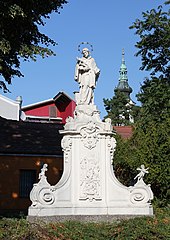Stefan Gabriel Steinböck
Stefan Gabriel Steinböck (* 1737 in Vienna , † 1783 ) was an Austrian master stonemason and sculptor of the Baroque . He became the imperial master stonemason and in 1774 head of the Wiener Bauhütte .
Life
Stefan Gabriel was born into a stonemason family, his father Gabriel Steinböck had decided to move from Eggenburg to Vienna by marrying Catharina Köchlin, widow of the Viennese stonemason Philipp Köchl, and is there in 1732 as a master stonemason. Through this marriage he took over the Köchls stonemasonry, and the way was clear to become master of the main Viennese hut.
As the elder son Franz Joseph led his son Stefan Gabriel the stonemasonry on, his father spoke to him on May 1, 1755 journeymen and brother of the Vienna stonemasonry work freely . He is first documented as a master in the Vienna Guild Book in 1763. After the death of his father in 1764 he took over the position of the imperial stonemason master under Maria Theresa .
Johannes Nepomuk monument in Langenzersdorf
The monument of St. Johannes Nepomuk in Langenzersdorf in the Weinviertel of Lower Austria was built in 1766 by kk Hofsteinmetzmeister Stefan Gabriel Steinböck. It rests on a high, three-armed volute base. Scenes from local history can be seen on the three pillars between the volutes .
Male house in Erdberg
For a long time the building housed the court hunters, male masters and male servants of the sovereign, who had to take care of the imperial hunting dogs . At times, for example during the reign of Maximilian I , who was a passionate hunter , up to four hundred dogs were kept in the Rüdenhof; Even bread was baked for them in their own ovens. During the Turkish siege of 1683 there was serious damage to the building, which was only poorly restored, in 1771 it was sold to the Erdberg community. The court building authority dealer Franz Friedrich Bandl, the bourgeois master builder Adalbert Hild, the court master carpenter Johannes Ohmeyer and the court stonemason Stefan Gabriel Steinböck wrote a detailed report about the condition at that time.
The Rüdengasse in Erdberg is a reminder of this .
Schönbrunn Castle
In the period 1770/1773 payments were made by the imperial chamber pay office to court stone mason Stefan Gabriel Steinböck for work in the park of Schönbrunn , on a pool etc. This corresponded to a project by the architect Johann Ferdinand Hetzendorf von Hohenberg in 1771/1772. He planned a large basin on the hill that would feed a number of fountains , for example four more on the great ground floor in addition to the Neptune fountain . Construction work began in 1773.
Delivery from the imperial quarry on Leithaberg
One of the stone deliveries to Viennese masters took place on April 13, 1772 from master Leopold Winkler from Kaisersteinbruch to Gabriel Steinböck. A load of stone with 4 pieces of slabs, 5 ordinary relay, 1 screw relay, wages
Michaelerkirche in Vienna
The high altar of the Michaelerkirche from 1781 can be seen in two sections, the altar with the miraculous image and the back wall with the angel's fall. The tumba-shaped cafeteria with the plait-like ornaments is surmounted by the cube-like tabernacle and flanked by the block-like side portals. The types of marble used show the pale colors typical of the late 18th century. Only the tabernacle and the canteen cladding are made of white Carrara marble. The stone carvings are by Stefan Gabriel Steinböck.
Daughter Anna Steinböck married Luigi Pichl (1782-1856), the architect of the Duke of Modena , whose palace in Vienna and the Lower Austrian country house he rebuilt.
literature
- Vienna City and State Archives : Steinmetzakten .
- Archive St. Michael in Vienna: Waldemar Posch, SDS, building history .
- Archives of Klosterneuburg Monastery : Johannes Nepomuk Monument in Langenzersdorf .
- Alois Kieslinger : Stone handicraft in Eggenburg and Zogelsdorf . In: Our home . Monthly newspaper of the Association for Regional Studies and Homeland Protection of Lower Austria and Vienna, No. 5-7, 1935.
- Hans Brandstetter: Eggenburg, history and culture . 1986.
- Burghard Gaspar: The white stone of Eggenburg. The Zogelsdorf sand-lime brick and its masters . In: The Waldviertel . Issue 4, 1995.
- Michaela Laichmann: The imperial dogs, the male house in Erdberg .. , Franz Deuticke , Vienna 2000.
- Helmuth Furch : Historical Lexicon Kaisersteinbruch . 2 volumes. Museum and cultural association, Kaisersteinbruch 2002–2004. ISBN 978-3-9504555-8-8 .
- Herbert Haupt: The handicrafts freed from court and court in baroque Vienna 1620–1770 . In: Research on Vienna City History . 2007. ISBN 978-3-7065-4342-2 .
| personal data | |
|---|---|
| SURNAME | Steinböck, Stefan Gabriel |
| BRIEF DESCRIPTION | Austrian master stonemason of the Baroque |
| DATE OF BIRTH | 1737 |
| PLACE OF BIRTH | Vienna |
| DATE OF DEATH | 1783 |
| Place of death | Vienna |


